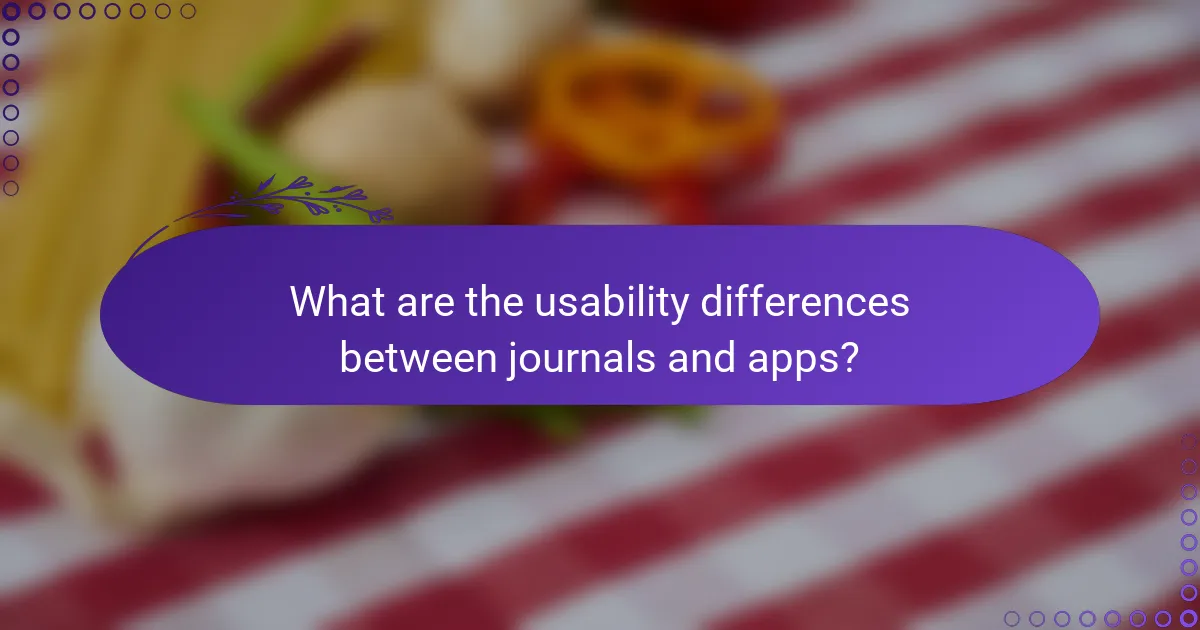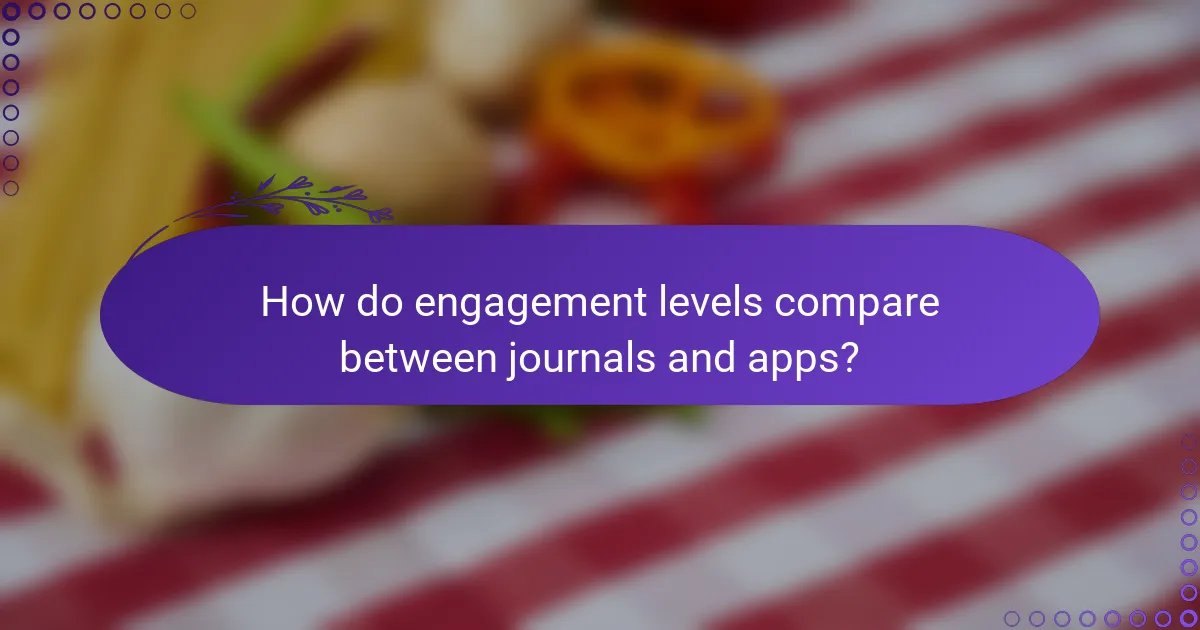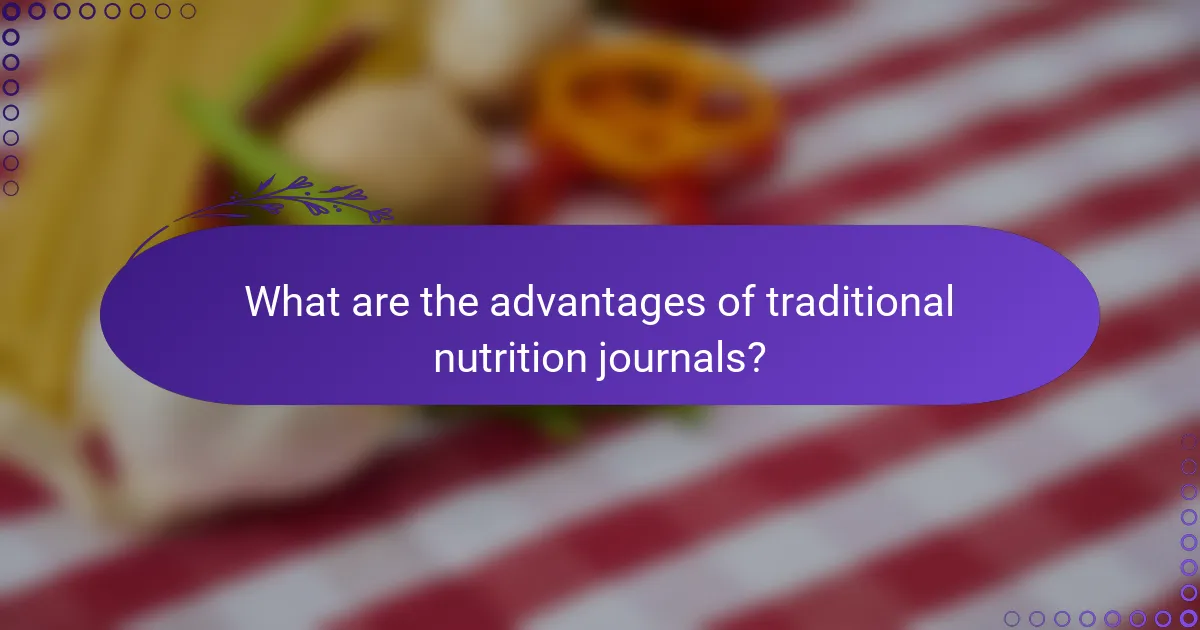In the realm of mindful nutrition tracking, both journals and apps present distinct benefits tailored to individual preferences and objectives. While journals foster a reflective and personal experience, apps deliver convenience and instant feedback, often enhancing user engagement through interactive features and gamification. Understanding the usability differences between manual entries in journals and the automated tracking capabilities of apps is essential for choosing the right method for effective nutrition management.
![]()
Which is better for mindful nutrition tracking: journals or apps?
Both journals and apps have unique advantages for mindful nutrition tracking, and the best choice depends on personal preferences and goals. Journals offer a reflective experience, while apps provide convenience and immediate feedback.
Journals offer personalized reflection
Using a journal for nutrition tracking allows individuals to express thoughts and feelings about their eating habits. This personal reflection can lead to deeper insights about emotional triggers and food choices, fostering a more mindful approach to nutrition.
Writing by hand can enhance memory retention and create a stronger connection to the food consumed. Consider setting aside a few minutes daily to jot down meals, feelings, and any patterns noticed.
Apps provide real-time data tracking
Nutrition tracking apps enable users to log meals instantly, making it easier to monitor calorie intake and nutritional values. Many apps come equipped with extensive food databases, allowing for quick searches and accurate logging.
Real-time data tracking can help identify trends in eating habits, making it easier to adjust dietary choices. Look for apps that allow customization of goals and provide reminders to maintain engagement.
Apps often include community support
Many nutrition tracking apps feature community forums or social sharing options, providing users with support and motivation. Engaging with others can enhance accountability and create a sense of belonging.
Participating in community challenges or sharing progress can boost motivation. However, be mindful of comparing your journey to others; focus on personal progress instead.
Journals enhance mindfulness practices
Journaling encourages a slower, more thoughtful approach to nutrition, promoting mindfulness. Taking time to reflect on meals can help individuals appreciate their food and recognize the emotional aspects of eating.
To enhance mindfulness, consider incorporating prompts in your journal, such as “What did I enjoy about this meal?” or “How did this food make me feel?” This practice can deepen the connection between food choices and overall well-being.

What are the usability differences between journals and apps?
The usability differences between journals and apps for mindful nutrition tracking primarily revolve around manual versus automated entry methods. Journals require users to input data manually, while apps often automate tracking, enhancing user engagement and ease of use.
Journals require manual entry
Using a journal for nutrition tracking means writing down every meal, snack, and drink. This manual entry can be time-consuming and may lead to inconsistencies if users forget to log items. However, some people prefer this method for its tactile nature and the ability to reflect on their eating habits.
To effectively use a journal, consider setting aside specific times each day to record your intake, such as after meals. This routine can help ensure that you capture all relevant information and maintain accuracy in your tracking.
Apps feature automated tracking
Nutrition tracking apps often include features that allow for automated data entry, such as barcode scanning or voice recognition. These functionalities can significantly reduce the time spent logging meals and increase the likelihood of consistent tracking. Many apps also sync with wearable devices to capture activity levels and caloric expenditure automatically.
When choosing an app, look for one that offers a comprehensive food database and easy integration with other health tools. This can streamline your tracking process and provide a more holistic view of your nutrition and health.
Apps offer user-friendly interfaces
Most nutrition tracking apps are designed with user-friendly interfaces that simplify the tracking process. Features like customizable dashboards, visual progress reports, and reminders can enhance user engagement and motivation. These interfaces often make it easier to analyze dietary patterns over time.
To maximize the benefits of an app, explore its features thoroughly and customize settings to fit your preferences. Engaging with the app regularly can help you stay accountable and make informed dietary choices.

How do engagement levels compare between journals and apps?
Engagement levels between nutrition tracking journals and apps differ significantly, with apps often providing more interactive features that enhance user motivation. While both methods have their merits, apps typically offer gamification elements that can lead to higher user engagement compared to traditional journaling.
Apps use gamification for motivation
Apps often incorporate gamification techniques, such as rewards, challenges, and progress tracking, to keep users motivated. For example, users might earn points for logging meals or completing daily goals, which can create a sense of achievement. This interactive approach can lead to increased adherence to nutrition tracking over time.
Additionally, many apps allow users to connect with friends or join communities, fostering a social environment that encourages accountability. This social aspect can significantly boost engagement, as users share their progress and support one another in their nutrition journeys.
Journals encourage deeper personal insights
Journals promote a reflective practice that can lead to deeper personal insights about eating habits and emotional triggers. Writing by hand can enhance mindfulness, allowing users to connect their feelings with their food choices. This process often leads to a better understanding of personal nutrition needs and preferences.
Moreover, journaling can be a creative outlet, enabling users to express their thoughts and feelings about food in a way that apps may not facilitate. However, the lack of immediate feedback and interactive features in journals may result in lower engagement levels compared to apps. Users should consider balancing both methods to maximize their nutrition tracking effectiveness.
![]()
What are the benefits of using nutrition tracking apps?
Nutrition tracking apps offer users convenient ways to monitor their dietary intake, making it easier to achieve health goals. These apps streamline the process of logging meals and provide instant feedback on nutritional values, enhancing user engagement and accountability.
Instant access to nutritional information
Nutrition tracking apps provide immediate access to a vast database of food items, allowing users to quickly find nutritional information. This feature helps individuals make informed choices about their meals, as they can see calorie counts, macronutrient breakdowns, and other essential details in real-time.
Many apps include barcode scanning, enabling users to log packaged foods effortlessly. This functionality minimizes the time spent searching for nutritional data and encourages consistent tracking.
Integration with wearable devices
Many nutrition tracking apps can sync with wearable devices, such as fitness trackers and smartwatches. This integration allows users to monitor their physical activity alongside their dietary habits, providing a comprehensive view of their health.
By combining data from both sources, users can better understand how their nutrition impacts their fitness goals. For example, some apps adjust daily calorie recommendations based on activity levels, helping users stay on track.
Customizable meal plans
Nutrition tracking apps often offer customizable meal plans tailored to individual dietary preferences and goals. Users can select specific macronutrient ratios, dietary restrictions, or calorie targets, making meal planning more personalized and effective.
Some apps even provide recipe suggestions and grocery lists based on the chosen meal plans, simplifying the shopping and cooking process. This feature can significantly enhance adherence to dietary goals by making healthy eating more accessible and enjoyable.

What are the advantages of traditional nutrition journals?
Traditional nutrition journals offer several benefits, including enhanced mindfulness and a creative approach to meal planning. By manually recording food intake, users can develop a deeper awareness of their eating habits and make more intentional choices.
Promotes mindfulness and reflection
Using a nutrition journal encourages individuals to pause and reflect on their food choices. This practice can lead to greater awareness of emotional eating triggers and help identify patterns in dietary habits. For example, noting feelings associated with meals can reveal connections between mood and food consumption.
To maximize mindfulness, consider setting aside a few minutes each day to review your entries. This reflection time can enhance your understanding of what foods nourish you and which ones may not serve your health goals.
Encourages creativity in meal planning
Traditional journals provide a blank canvas for users to explore their culinary creativity. By jotting down meal ideas, recipes, and ingredient combinations, individuals can experiment with diverse foods and flavors. This can lead to more enjoyable and varied diets, which are essential for long-term adherence to healthy eating.
To foster creativity, try dedicating a section of your journal to brainstorming new meals or snacks each week. You might include seasonal ingredients or explore different cuisines, making meal planning a fun and engaging process.
![]()
How to choose between a journal and an app for nutrition tracking?
Choosing between a journal and an app for nutrition tracking depends on your personal preferences, lifestyle, and goals. Journals offer a tactile experience, while apps provide convenience and advanced features for tracking and analysis.
Assess personal tracking preferences
Start by evaluating how you prefer to document your meals. If you enjoy writing and reflecting on your food choices, a journal may suit you better. Conversely, if you prefer quick entries and instant feedback, an app could be more effective.
Consider the level of detail you want in your tracking. Journals allow for personalized notes and reflections, while apps often include features like barcode scanning and nutritional databases, making it easier to log meals accurately. Think about whether you want a simple record or a comprehensive analysis of your nutrition.
Additionally, assess your comfort with technology. If you are tech-savvy and enjoy using your smartphone, an app can enhance your tracking experience. However, if you prefer a break from screens, a traditional journal might be more appealing.

